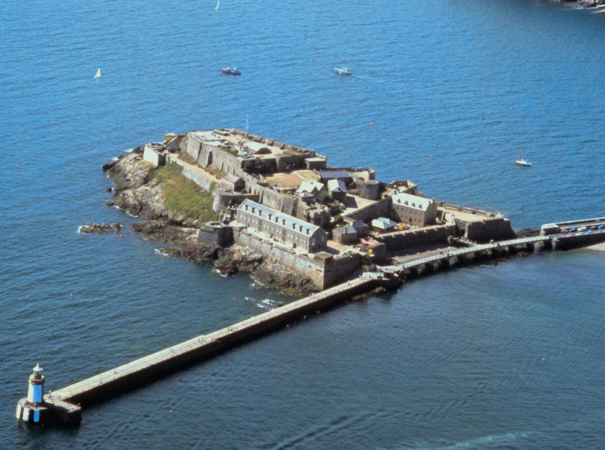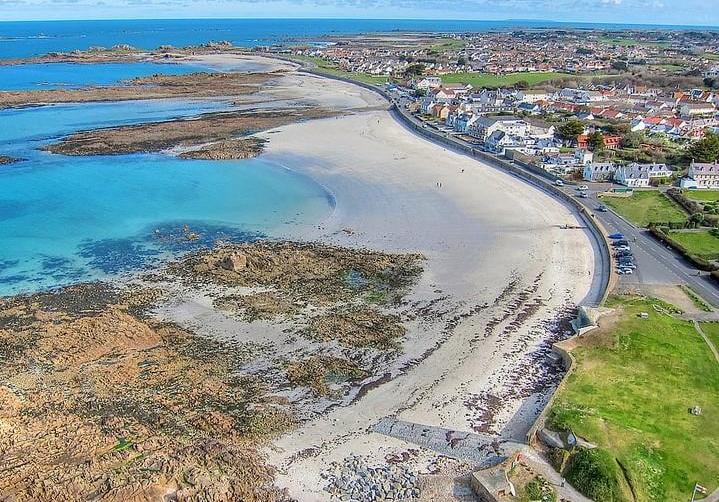For many UK based boats a visit to Guernsey is a day sail during the summer. For those who want to maximise their time on a short trip to the island, one overnight passage will get you there from pretty much anywhere on the UK’s south coast.
But Guernsey is much more than a single island, instead it is the centrepiece in a beautiful, immaculate, extraordinary, and varied destination. Those that arrive for the first time, frequently end up extending their trips not just by the odd day, but by weeks or even months at a time.
For many, the ease of access to the island’s main harbour, St Peter Port (pictured right), with its array of services, bars restaurants and shopping just a stone’s throw from the dock is the main focus. It’s easy to arrive, moor up and not move for the entire time you are there.
Yet, just a few miles to the south are two idyllic, unspoilt sandy bays, Moulin Huet Bay and Petit Port that make for perfect daytime anchorages if the wind has any north or east in it.
Climb the 270 steps up through the cliff in Petit Port and you are rewarded with spectacular views over Guernsey and the surrounding islands.
Of the five marinas on Guernsey only two are available for visitors, Victoria Marina in St Peter Port and Beaucette Marina (pictured left) on the northern tip of the island which is well worth a visit. A former quarry, the entrance was created by blasting through the granite to create a spectacular entrance.
In keeping with the entire area, an up to date pilot book and charts are essential here. Access is tight through the 18m gap in the rock and there is a sill at the entrance so access is +/-3 hours HW.
Once inside, this tranquil and protected snug harbour provides a peaceful alternative to the hustle and bustle of St Peter Port. No traffic, no crowds and no noise other than birdlife. The Saltwater Restaurant on site is also well worth a visit.
Guernsey’s often turbulent history from medieval times to the Second World War has left an array of distinct and unmissable fortresses around every vantage point on the island. As you enter St Peter Port, the largest and most striking is Castle Cornet (pictured right), on the south side of the entrance to the harbour. The 800 year old castle set on what was originally an island is a must visit, houses five museums and hosts a range of tours, festivals and special events. (When you’re there, make sure to drop in on the Guernsey Yacht Club which sits alongside, towards the end of the pier. A friendly club with a terrific view of the harbour and islands to the east.)
Military history and stark reminders of the German occupation are on display wherever you go, with the island hosting several fascinating museums and fortresses. Three in particular stand out: La Valette Underground Military Museum; the German Naval Signals HQ; and The German Occupation Museum.
The west coast of the island faces straight out into the Atlantic and offers spectacular, rugged scenery and is great for surfing. It is not generally a place to sail to and anchor due to the exposed nature of the rocky coastline but it is well worth a visit. So, just drive, cycle, take the bus or hire a scooter, just get there, see it and soak up the invigorating fresh air from the Western Approaches and the Atlantic. Our two favourite beaches on the west coast are at opposite ends, but each is well worth a visit: Grandes Rocques Beach and Portelet Beach.
Elsewhere the coastal walks are equally spectacular, in particular the walk along the south coast between Petit Port and Saints Bay.
Just 3 miles to the east of St Peter Port lies the island of Herm (pictured right). Whether it is for a few hours or the whole day, a trip to this special yet tiny island of just over 500acres is a must. Easily accessible using regular ferries a visit to Shell Bay on the east coast should also be on your agenda, as should a visit to the Mermaid Tavern and Restaurant. The main anchorage is off Rosiere Steps towards the south of the island by approaching through the Percee Passage. It’s snug and the tide runs fast through here so its important to check your pilot.
Further to the east lies the larger island of Sark (below) which is also an absolute must.
With no cars, just horses, bicycles and the odd tractor, you will wonder why you ever found modern life appealing. Again, you can visit by ferry or you can pick up one of the visitors mooring buoys at Harve Gosselin and climb the 299 steps which at the top gives a spectacular view. Alternatively you can head to the east side of the island to La Greve de la Ville or the anchorages in Dixcart Bay or Derrible Bay.
Oyster 565 owner Stephen Haines lives on Guernsey and also owns the extraordinary, Beaucette Marina.
“Every summer you can pretty much guarantee to see seals, bottle nosed dolphins and sunfish among the sea life, the waters are crystal clear, the pace of life is relaxed - I could go on and on... What people who haven’t been here before don’t appreciate until they come is how Guernsey is a stepping stone to a much bigger destination.”
The westernmost of all the Channel Islands, Guernsey’s location in the English Channel makes it a target for changeable weather. Nevertheless, good shelter in the marinas and its close proximity to mainland UK make this an easy island to plan to visit.
The tip? Take your time and wait for the good weather to come, it rarely takes long for a window to appear.
Important note:
These cruise guides are intended as food for thought only based on the experiences of those who have been there and do not form a definitive guide. The locations should always be studied using the appropriate pilots and charts.
Pilot book suggestions:
In most cases there are many useful pilot books and guides that are available and should be consulted before and during the trip. Among those that come highly recommended are:
OTHER SAILING GUIDES
What people who haven’t been here before don’t appreciate until they come is how Guernsey is a stepping stone to a much bigger destination.





